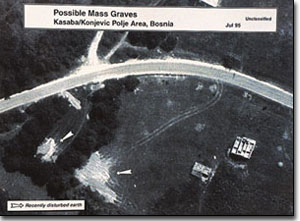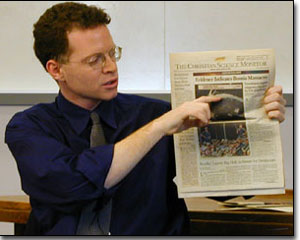


Stage 1 - Investigates Photo
August 10-13, 1995
Video:
david and faye tell their story
Related Issues:
Ethics
Editor's Story
Articles: "Piecing Together the Massacres"
On Aug. 10, 1995, the Clinton administration released photographs taken by U.S. spy planes of a field near Srebrenica, Bosnia, showing disturbed earth that suggested mass grave sites.

Citing alleged war crimes as justification for intensifying NATO intervention in the Bosnian conflict, U.S. Secretary of State Madeleine Albright introduced the photos in a meeting of the U.N. Security Council.
Before the war, Srebrenica (pronounced sreh-BREH-nih-tsah) was known only as a quaint mining town of 9,000 people that took its name from the Serbo-Croatian word for silver, srebro. But it had been a subject of concern since July 1995, when Bosnian Serb forces took the area. Rumors of mass executions of Muslims from a "safe area" guarded by UN peacekeeping forces had been circulating for weeks. As more time passed, evidence of the crime would disappear. Getting the story was not a race against the competition, but a race against Serb forces who did whatever they could to cover it up.
Satellite photo used by David Rohde to track down suspected mass graves. Photo: AP
The Christian Science Monitor takes on the story
Journalists from all the major U.S. newspapers noted the mounting evidence of mass killings, but only David Rohde of The Christian Science Monitor decided to go to the area to investigate the story. Rohde was in daily contact with his editor, Faye Bowers, to discuss his plans. Rohde credits Bowers for having played an equally important role in the story. It was Rohde's first war as a reporter. It was not Bowers' first war as an editor.
A native of Maine and 1990 graduate of Brown University, Rohde worked from Belgrade, Sarajevo and Zagreb where he had covered East Europe for The Monitor since November 1994.
Tipped off first by a wire report of atrocities against Muslims, Rohde hired a translator and a driver and entered Bosnian Serb-controlled territory on August 12 to investigate the alleged mass killings. En route, a Serbian soldier inadvertently confessed to committing executions. "We just talk to them and then shoot them," Rohde reported one soldier to say.

David Rohde discusses how he reported the series of stories about suspected mass graves in Bosnia during Prof. Anne Nelson's International Reporting Class at Columbia University. Photo: Ian Wilhelm
Rohde investigated the area thoroughly. He walked acres of territory and drove hundreds of kilometers. He interviewed civilians and combatants and talked to intelligence experts in Belgrade to find and collect the first on-the-ground evidence of mass executions.
In an abandoned building at the Bratunac soccer stadium, Rohde found graphic evidence that prisoners were confined, possibly tortured, and killed. But, he did not find the graves. He needed more. Rohde returned to Belgrade to obtain a copy of the CIA satellite photo.